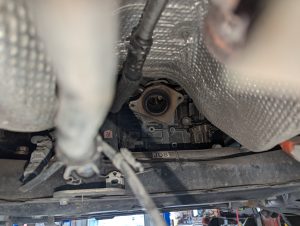If it feels like you’re suddenly reading a lot about catalytic converter theft, it’s not just your imagination. These parts are being stolen throughout the country, and Austin, Texas is no exception.
In this article, we’ll cover everything you need to know about catalytic converter theft, including a few tips to protect yourself and mitigate the damage if it does happen.
What is a Catalytic Converter, and Why Are They Being Stolen
Catalytic converters, commonly called cats, are a part of your car’s exhaust system. It converts toxic gases from this system into less poisonous gases through the magic of science, which we won’t even begin to get into.
Pictured: A catalytic converter doing science
Cats have become a popular target for thieves for a couple of reasons. First, they’re pretty easy to steal. It only takes a saw and a few minutes to slice into the exhaust system. It’s much faster and easier than breaking into a car and hoping something valuable is inside.
Once a thief has a pile of catalytic converters, it’s off to the scrapyard. Cats are made of metals that have risen in value recently, so a single night’s work can net a decent profit. Since it’s impossible to tell if a catalytic converter is stolen, many scrapyards won’t even accept small numbers of cats unless the seller can prove ownership. However, enough do to make this kind of theft profitable.
Which Vehicles Are Most Likely Targets for Catalytic Converter Theft?
According to Carfax, the vehicles most often targeted for catalytic converter theft in the Southern US are:
- 1985-2021 Ford F-Series
- 1989-2020 Honda Accord
- 2007-17 Jeep Patriot
- 1999-2021 Chevrolet Silverado
- 1990-2022 Ford Econoline
- 2007-21 Jeep Compass
- 1993-2020 Nissan Altima
- 2008-14 Dodge Avenger
- 2011-17 Chrysler 200
- 2011-19 Chevrolet Cruze
Based on some very unofficial research of our own, the Toyota Prius seems to be a popular target in Austin and elsewhere. Hybrids tend to make a more attractive target for cat theft simply because their catalytic converters are of higher quality than other vehicles. Better quality cats sell for more since the metals are less likely to be corroded.
Of course, a determined thief will steal from just about anyone. Even if your vehicle isn’t on this list, it’s better to be prepared rather than risk expensive repairs.
How Can I Prevent Catalytic Converter Theft?
The best way to protect yourself from catalytic converter theft is to make it as difficult as possible for thieves to access and steal your cat. As we said, part of what makes this particular crime attractive is that it’s fast and easy.
If you have a garage, that’s an obvious solution. Park in it, put an alarm on it, and problem solved. It’s unlikely that someone out to steal catalytic converters will go to the trouble of breaking into a garage.
Cameras are also a good idea if you park outside. Put them in prominent places and point them at your car. Hopefully, thieves will notice and move on to an easier target. If not, at least you’ll have footage of the event.
These thieves tend to strike multiple times in the same neighborhood. If you have a neighborhood watch, it’s worth informing everyone to be on the lookout for this kind of crime.
Some devices claim to prevent catalytic converter theft. You have many options, from custom-fabricated cages, to kits you can order off the internet and install yourself. Some are better than others (and we don’t have any recommendations), but they all serve the same purpose: making it more challenging to cut out and steal your cat.
However, these devices can backfire. A particularly determined thief may do extreme damage to your car to defeat the anti-theft device and steal your catalytic converter. It’s definitely a calculated risk.
One reason cats are stolen so often is that they don’t have your car’s VIN on them. You can engrave your VIN or license plate number onto the cat yourself, but you must be careful not to damage the part. A more obvious option is to paint your catalytic converter with fluorescent paint, then write your VIN on the painted surface.
How Can I Tell My Catalytic Converter Has Been Stolen?
If your catalytic converter has been removed, your first clue will be the unwelcome glow of your check engine light. You’ll also know something is wrong when you press the gas. There will be a loud roaring noise, and the acceleration will feel jerky. Finally, there is often a strange odor since the toxins produced by your car are no longer being converted.

At this point, it’s likely your car isn’t safe to drive. Not only can you further damage the vehicle, but you can also seriously harm yourself by breathing in dangerous fumes. It’s best to have your car towed to your mechanic so they can assess the damage.
What Does it Cost to Replace a Catalytic Converter?
Depending on your vehicle and the extent of the damage, you could be looking at up to $4,500 to replace a catalytic converter. Your insurance may cover the cost if you have comprehensive coverage. Otherwise, you’ll likely be stuck with the bill.
Beyond those immediate costs, being without your car can be expensive. Public transit in Austin isn’t the best, and rideshares can be expensive.
This is something you’ll want to fix as soon as possible. In some cases, thieves cut the coolant lines, and driving the car in this condition can lead to engine failure. If you suspect your catalytic converter has been stolen, contact us; we’ll gladly help.
